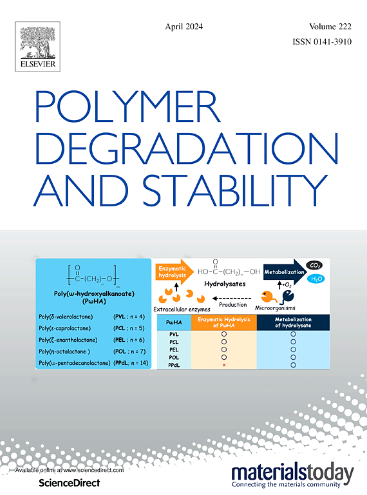Vanillin-derived bio-based epoxy resins containing dual dynamic Schiff base and disulfide bonds with reprocessability and degradability
IF 6.3
2区 化学
Q1 POLYMER SCIENCE
引用次数: 0
Abstract
Incorporating reversible covalent bonds into the crosslinked matrix of bio-based epoxy resins can address the challenges of difficult degradation and sustainable development associated with petroleum-based epoxy resins. However, the dynamic capability conferred by a single dynamic chemical bond proves relatively insufficient in thermosetting polymers. Therefore, we propose a strategy to introduce proportionally adjustable dual dynamic covalent bonds in the bio-based epoxy resin system to leverage the advantages of different dynamic bonds and improve the dynamic properties of the resulting epoxy vitrimers in this study. First, a bio-based epoxy monomer (BVF-EP) derived from vanillin was prepared and cured with a diamine hardener (AFD). Subsequently, vanillin-derived epoxy vitrimers were prepared by varying the stoichiometric ratio of AFD to BVF-EP (R = 0.5, 1.0, and 1.5) without catalysts. Some of the vitrimers showed good thermal stability and excellent reprocessability and degradability. Notably, BVF-EP/AFD (R = 1.5) containing both dynamic reversible covalent bonds of S-S and C=N with the highest crosslink density, exhibited the highest thermal decomposition temperature, highest tensile modulus (7175 MPa), and the shortest stress relaxation time (6 s at 200 ℃). Simultaneously, BVF-EP/AFD (R = 1.5) demonstrated good multiple reprocessing capacity under a pressure of 5 MPa at 140 ℃. It can be completely degraded in two distinct mixed solutions (50 % DMF/50 % β-ME and 50 % 1 M HCl/50 % DMF), offering great potential in recovering high-value carbon fibers from its carbon fiber-reinforced composites. This work advances the development of bio-based epoxy resins with dual dynamic crosslinked networks, providing new insights for the degradation and reprocessing of thermoset polymers.
香兰素衍生生物基环氧树脂,含有双重动态希夫碱和二硫键,具有可再加工性和可降解性
在生物基环氧树脂的交联基体中加入可逆共价键,可以解决石油基环氧树脂难以降解和可持续发展的难题。然而,单个动态化学键赋予热固性聚合物的动态能力相对不足。因此,我们在本研究中提出了一种在生物基环氧树脂体系中引入可按比例调节的双动态共价键的策略,以充分利用不同动态键的优势,改善所得环氧树脂玻璃体的动态性能。首先,制备了由香兰素衍生的生物基环氧单体(BVF-EP),并用二胺固化剂(AFD)固化。随后,在不使用催化剂的情况下,通过改变 AFD 与 BVF-EP 的化学计量比(R = 0.5、1.0 和 1.5),制备了香兰素衍生环氧树脂缩微体。其中一些硅胶具有良好的热稳定性、出色的再加工性和降解性。值得注意的是,BVF-EP/AFD(R = 1.5)同时含有交联密度最高的 S-S 和 C=N 动态可逆共价键,表现出最高的热分解温度、最高的拉伸模量(7175 兆帕)和最短的应力松弛时间(200 ℃ 时为 6 秒)。同时,BVF-EP/AFD(R = 1.5)在 140 ℃、5 兆帕压力下表现出良好的多次再处理能力。它可以在两种不同的混合溶液(50 % DMF/50 % β-ME 和 50 % 1 M HCl/50 % DMF)中完全降解,为从碳纤维增强复合材料中回收高价值碳纤维提供了巨大潜力。这项工作推动了具有双动态交联网络的生物基环氧树脂的发展,为热固性聚合物的降解和再加工提供了新的见解。
本文章由计算机程序翻译,如有差异,请以英文原文为准。
求助全文
约1分钟内获得全文
求助全文
来源期刊

Polymer Degradation and Stability
化学-高分子科学
CiteScore
10.10
自引率
10.20%
发文量
325
审稿时长
23 days
期刊介绍:
Polymer Degradation and Stability deals with the degradation reactions and their control which are a major preoccupation of practitioners of the many and diverse aspects of modern polymer technology.
Deteriorative reactions occur during processing, when polymers are subjected to heat, oxygen and mechanical stress, and during the useful life of the materials when oxygen and sunlight are the most important degradative agencies. In more specialised applications, degradation may be induced by high energy radiation, ozone, atmospheric pollutants, mechanical stress, biological action, hydrolysis and many other influences. The mechanisms of these reactions and stabilisation processes must be understood if the technology and application of polymers are to continue to advance. The reporting of investigations of this kind is therefore a major function of this journal.
However there are also new developments in polymer technology in which degradation processes find positive applications. For example, photodegradable plastics are now available, the recycling of polymeric products will become increasingly important, degradation and combustion studies are involved in the definition of the fire hazards which are associated with polymeric materials and the microelectronics industry is vitally dependent upon polymer degradation in the manufacture of its circuitry. Polymer properties may also be improved by processes like curing and grafting, the chemistry of which can be closely related to that which causes physical deterioration in other circumstances.
 求助内容:
求助内容: 应助结果提醒方式:
应助结果提醒方式:


